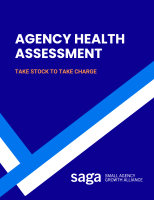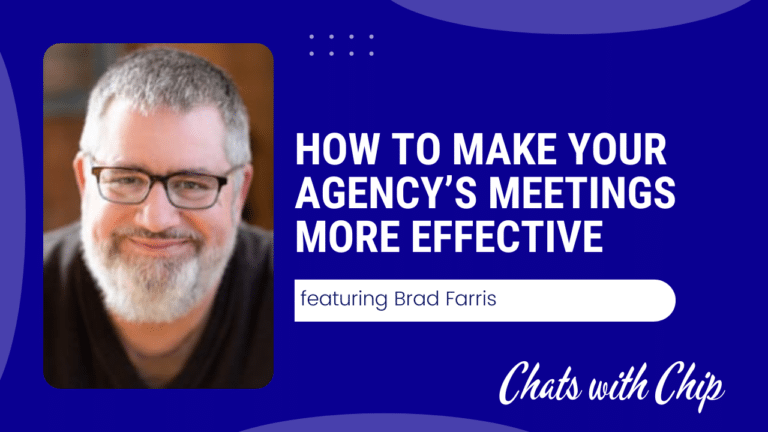For PR and marketing agencies, internal communication matters just as much as the campaigns executed for clients. One-on-one meetings often get overlooked, but they play a vital role that can significantly enhance internal dynamics and drive agency success.
Every manager – including the agency owner – should be having weekly 1:1 meetings with their direct reports. There should be no exceptions.
Even if you talk every day, the 1:1 provides additional value that should not be overlooked.
Recognizing the value of one-on-one meetings
Weekly 1:1 sessions are not just routine check-ins. It isn’t about getting updates that could be (and should be) shared by email or in a project management tracking tool.
These meetings empower employees and help produce better results for the agency. They provide an outlet for individual team members to share concerns or ideas that they might not otherwise bring forward.
Understanding the role of managers in one-on-one meetings
Many first-time managers think that their job is to assign tasks and demand results from their team members.
While managers obviously play an important role in allocating workloads and supervising progress, these should not be at the forefront.
The most effective managers serve as mentors and coaches to their team members. They work to find ways to eliminate obstacles that are holding them back and taking advantage of opportunities that present themselves.
Going into a 1:1 session, the manager should be focused on determining how they can help free up their direct reports to be more successful and productive, rather than thinking about it as an opportunity to insist on accountability.
Key objectives of one-on-one meetings
While a good 1:1 will produce many positive outcomes, the focus should be on several core areas:
- Enhancing communication. Beyond routine updates, these meetings are opportunities to build trust, understand personal and professional challenges, and align on goals and expectations. It takes the conversation out of the daily tasks and elevates the discussion to improve the manager-employee relationship.
- Identifying and addressing issues early. Regular one-on-ones allow leaders to catch potential problems before they escalate, from project misalignments to individual team member challenges. The sooner a challenge or opportunity comes to light, the more effectively the manager can deal with it.
- Boosting employee engagement and retention. These meetings can significantly improve morale and job satisfaction by providing a regular venue for honest dialogue. Listening to what direct reports have to say – and then acting upon that knowledge – helps to elevate the performance of managers.
- Breaking down barriers and removing obstacles. Managers need to set their direct reports up for success by clearing out anything that is in their way – whether that is delayed feedback from clients, lack of available resources, additional training, unrealistic expectations, or something else.
Optimizing the structure of one-on-one meetings
Each manager and employee will end up tailoring their meetings to the way that they work most effectively together, but the following structure tends to work well in most situations.
- Let the employee lead. A common mistake is to have the manager run these meetings, but the greatest effectiveness comes from putting the employee in charge. It often takes time to make the employee comfortable with this approach, so the manager needs to work hard in the early sessions to create an open atmosphere.
- Share updates separately. If there are routine items that need to be communicated, do so outside of the 1:1. Like most meetings, the time should be sent talking, not reciting a list of completed or planned tasks.
- Have an agenda. Although employee-driven, leaders should ensure the agenda includes discussions on career development, major client challenges and opportunities, and any obstacles the employee faces. Ideally the agenda is shared in advance, but either way it should be agreed to at the start of the meeting by both manager and employee to ensure there is sufficient time to cover everything needed.
- Consider the location and atmosphere. The setting of these meetings can be varied to maintain engagement. While office settings or Zoom calls are standard, occasionally changing the location to a neutral place like a café or conducting a walking meeting can lead to more open exchanges.
- Spend more time listening than talking (as the manager). It is tempting to want to just issue direction or dispense wisdom, but the real value comes from actually listening to what your team members have to say. If you find yourself talking more than the employee in these sessions, then you are unlikely to be getting the most value from them.
- Include manager feedback. Managers need to have an opportunity to share constructive feedback in these sessions, too. It is important to be clear about expectations and coach performance as needed. This ensures that regular performance reviews won’t surface any surprise issues or concerns.
- Be clear about follow-up and next steps. Each 1:1 meeting should end with a clear understanding of any commitments that either the manager or employee has made. In subsequent sessions, these action steps should be reviewed to ensure progress is being made.
Implementing a one-on-one meeting culture
Building a culture that values one-on-one meetings requires commitment from the owner. If you aren’t doing regular weekly 1:1 meetings with your own direct reports, it is difficult to expect them to do the same with theirs.
Leaders should demonstrate the importance of these sessions through consistency and engagement. Training managers to conduct effective one-on-ones and setting expectations for frequency and format are crucial steps.
Since many of your managers may never have run these types of meetings before, you need to help educate them on both the value and best practices to get the right results.
Questions managers should ask in one-on-one meetings
During these sessions, employees may need some help in opening up to their managers – especially if 1:1’s have not been commonplace in the agency.
Some questions that managers can use to drive a more productive conversation include:
- What are the biggest obstacles for you right now?
- What could we be doing better for client X?
- What tactics are working particularly well right now?
- What are you working on to improve and how can I help?
- How is client X to work with?
- What are you hearing from your own direct reports?
- What should we be doing more or less of?
- What questions do you have for me?
These questions represent a starting point for you to find ways to engage with your team members and get them to open up to you as much as possible.
However, there is one question that you should always ask in every 1:1 meeting:
What do you need from me?
Conclusion
Regular and effective one-on-one meetings foster a supportive atmosphere that improves performance and facilitates professional growth. They contribute to a culture of transparency, encourage loyalty, and enhance the agency’s ability to adapt to changes swiftly and effectively.
These meetings are not administrative necessities but rather strategic tools that build stronger teams and drive agency success. By prioritizing and mastering one-on-one meetings between all managers and employees, agency leaders can ensure their team thrives.











